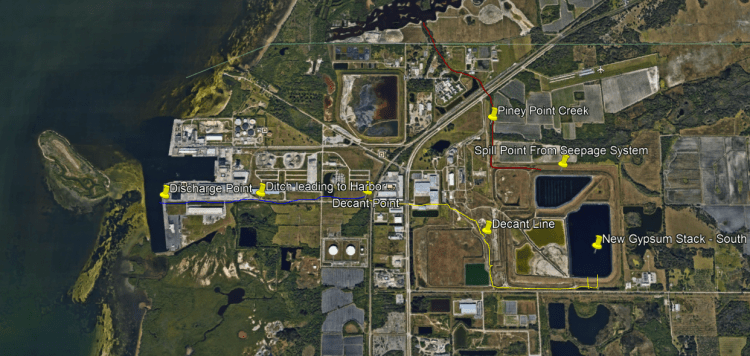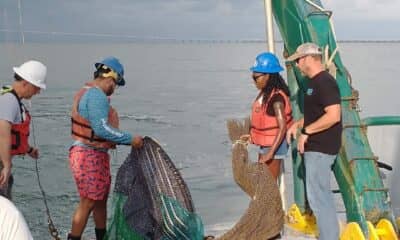Thrive
Piney Point nears capacity, could overflow, DEP warns

The Florida Department of Environment Protection (DEP) warns that summertime rainstorms and tropical weather could cause the Piney Point phosphate mining facility to overflow – possibly prompting another wastewater release.
In a press release Tuesday, the DEP stated that the storage capacity for additional rainfall at the site in Manatee County was just 11 inches. Piney Point has received over 25 inches since the beginning of June, and at least another eight inches of rain is expected by the end of September. According to the National Weather Service, the Tampa International Airport has received over two inches of rain in the two days since the press release, with more in the forecast today. The DEP stated the capacity is expected to change with rainfall amounts, along with water management activities at the site – including releases.
The former phosphate mining facility released about 215 million gallons of wastewater into Tampa Bay in April to prevent an imminent collapse that would have flooded surrounding neighborhoods. By May 23, Karenia Brevis – the organism that causes red tide and feasts on the nitrogen-rich wastewater – had reached bloom levels in Tampa Bay. By July, the Tampa Bay and Pinellas County coastline was in the midst of the worst red tide event in 50 years. Since the original spill, the DEP, the facility’s property managers, and independent contractors have worked to manage the water levels in Piney Point’s reservoirs.
Kelli Levy, Director of Public Works for Pinellas County, told the Catalyst that she considers them keeping the wastewater onsite since the catastrophe “a win” but is concerned for what the future will bring.
“There’s only so much storage capacity at that property,” said Levy. “We know that water has to go somewhere.”
“The question is more of a matter of when and how much, and what quality.”
The plant has a stormwater system that periodically releases that water, which is authorized and not as harmful as the water contained in the gypsum stacks released under an emergency order. The DEP said that “innovative technology companies” have been onsite treating water since April, and as a result, “Total Phosphorous and Total Nitrogen have been significantly reduced.”
However, officials still worry about the treated water’s effect on the local ecosystem, especially as red tide has begun to clear in the area.
“It’s not nitrogen-free, it still has nitrogen in it, and excess nitrogen in waterways is a problem,” said Levy. “We still have ongoing algal blooms in the bay, not red tide, but we have other algal blooms going on in the bay, and we still have red tide on the coast.”
As of Tuesday, the DEP said that about 261 million gallons of wastewater are held within the NGS-South reservoir. That water is a mixture of phosphogypsum – a radioactive byproduct of phosphate mining – and seawater. If it overflows, Bishop Harbor will once again bear the brunt of the release.
“Any other releases from the stacks of nutrient-rich water are something we don’t want to see, but we do know that the likelihood is it will have to happen because there’s just so much capacity at the site,” said Levy. “Again, it goes back to timing, volume, and quantity.”
“That’s what we’re all kind of watching for.”
On Aug. 5, the DEP filed a complaint in the 12th Judicial Circuit Court of Manatee County, initiating an emergency hearing of its lawsuit against Piney Point’s property managers – HRK Holdings. On Aug. 25, a judge issued an order appointing a receivership to serve as an independent third party to oversee the management and closure of the site. Day-to-day management of the site will now come from that receiver, and the DEP said it will continue performing its “stringent regulatory oversight of the facility.”
“The ultimate goal remains closure of the site once and for all,” wrote the DEP. “The receiver appointed last week will pave the way to expediting this process.”








Tanya Fitzgerald
September 8, 2021at12:55 pm
What are they doing with ALL that nasty water? 💧
C Graber
September 8, 2021at8:18 am
Here are a few options:
1. Rent a supertanker and run loads out to the middle of the ocean where the million cubic kilometers of water will ratio it to nothing.
2. Create a evaporation fountains system to 1000% increase evaporation process of the water from the waste.
3. Sell/pay for reduction the fertalyzer water to a company that can process it to useable elements.
William Kolarsick
September 2, 2021at8:33 pm
Please turn off the service now. Stop Polluting our Gulf. We need to start something new that works. Stop giving out Building permits to build new buildings until we fix this problem. We have killed enough sea Life.
Marie Tripi
September 2, 2021at4:49 pm
Piney Point should pay for the fish kill and red tide costs.